Also see Photos of other brown birds that look like HOSP, HOSP egg photos, more HOSP nest photos, HOSP management, attacks, history, numbers, behavior, nest and egg ID, HOSP euthanasia and more photos of HOSP nests in boxes, photo of HOSP in flight. All photos on this page by E.A. Zimmerman.
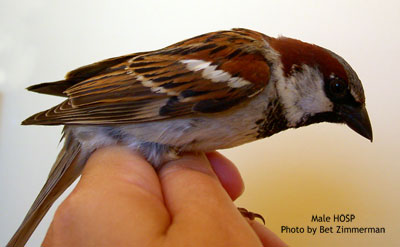 Beak of this male House Sparrow (HOSP) is black, the female’s (below) is more brown/buff colored. Photo taken during breeding season. Beak of this male House Sparrow (HOSP) is black, the female’s (below) is more brown/buff colored. Photo taken during breeding season.
To compare to other similar birds, see Other Brown Birds The breast of both the female and male is dingy, but NOT striped (although it looks a little striped in the photo of the female below. Back has black streaks. |
||
 Female HOSP are more difficult to identify than males. They are dull gray with a light streak at and behind the eye. Both male and female have a dingy grayish/buff breast without stripes. Female HOSP are more difficult to identify than males. They are dull gray with a light streak at and behind the eye. Both male and female have a dingy grayish/buff breast without stripes.
Juveniles look like females but are browner above and more buff-colored below, with pinkish bills, legs and feet. |
||
 Female House Sparrow, photo by Dave Kinneer. The colors in this outdoor shot are more true than some of the others on this page. Notice the beak color fo the female, chunky body style (although the bird is puffed up), and pink legs. Female House Sparrow, photo by Dave Kinneer. The colors in this outdoor shot are more true than some of the others on this page. Notice the beak color fo the female, chunky body style (although the bird is puffed up), and pink legs.
|
||
|
|
||
|
|

|
|
|
Cap is gray (see below), not chestnut like a Chipping Sparrow. Coloring on individual birds varies. Also notice strong finch beak. |
||
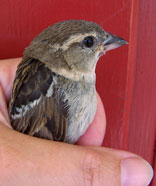 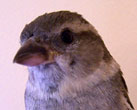 Female HOSP heads. Notice strips above eye, and lighter colored “collar.” Beaks are not black like male during breeding season. Female HOSP heads. Notice strips above eye, and lighter colored “collar.” Beaks are not black like male during breeding season. |
||
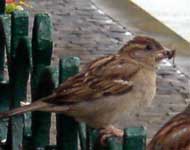  Adult HOSP will feed insects to nestlings (this female has an insect in her beak). However, in agricultural areas, on average about 96% of the House Sparrows’ diet consists of livestock feed, grains from fields and in storage, and weed seeds, and only 4% from insects. Urban birds tend to eat more commercial birdseed, weed seed, and human scraps. See HOSP History for information on how HOSP were introduced and became so widespread. Adult HOSP will feed insects to nestlings (this female has an insect in her beak). However, in agricultural areas, on average about 96% of the House Sparrows’ diet consists of livestock feed, grains from fields and in storage, and weed seeds, and only 4% from insects. Urban birds tend to eat more commercial birdseed, weed seed, and human scraps. See HOSP History for information on how HOSP were introduced and became so widespread. |
||
|
Photo of underbelly of male HOSP taken in May. Legs are pinkish/yellow. |
||
 |
||
| Photo above of male House Sparrow by Dave Kinneer. | ||
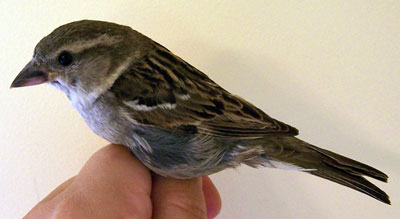 Female HOSP. Photo below by Dave Kinneer. Female HOSP. Photo below by Dave Kinneer. |
||
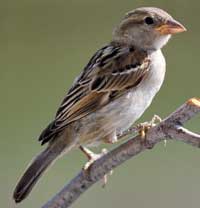 |
||
|
H They build a tall nest, which usually has a tunnel-like entrance, especially when built outside of a nestbox. Photo of HOSP nesting in sign by Donna. See more HOSP nest photos. Also see photos of HOSP nests in commercial establishments. Eggs are cream, white, gray or greenish, with irregular brown speckles. See more HOSP egg photos. |
||
 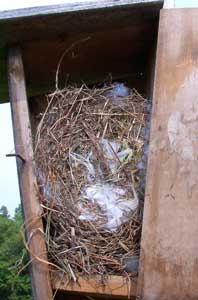 |
||
| IMPORTANT: SOME NATIVE BIRDS also lay speckled eggs. CHECK FIRST before removing nests! See EGG ID Matrix | ||
 I call this one “Green Eggs and Trash.” These eggs have a distinctly greenish cast. I call this one “Green Eggs and Trash.” These eggs have a distinctly greenish cast.
Note seed head, feathers, hair and cellophane in nest cup. Nest construction and reconstruction is rapid, so removal of nests tends to be an ineffective control method. Be aware that some other cavity nesters build messy nests (e.g., Great crested flycatcher), and a few also have brown speckled eggs. |
||
 HOSP eggs relative to an American quarter. See more HOSP egg photos. HOSP eggs relative to an American quarter. See more HOSP egg photos. |
||
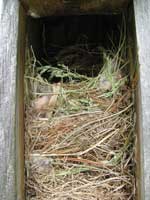 |
||
|
See House Sparrow Management for information on passive and active HOSP control methods. It IS possible, by consistently using a combination of passive and active control methods over time, to almost eliminate House Sparrows from your neighborhood, or at least to ensure that they are not a serious threat to native cavity nesting birds. |
||
 Flock of HOSP outside Notre Dame in Paris. (My traveling companion did find it odd that I was photographing HOSP instead of the historical monuments surrounding us.) HOSP were introduced to the U.S. from Europe, and are now the most abundant “songbird” on the continent,with an estimated 150 million birds established in all 48 states. Flock of HOSP outside Notre Dame in Paris. (My traveling companion did find it odd that I was photographing HOSP instead of the historical monuments surrounding us.) HOSP were introduced to the U.S. from Europe, and are now the most abundant “songbird” on the continent,with an estimated 150 million birds established in all 48 states. |
||
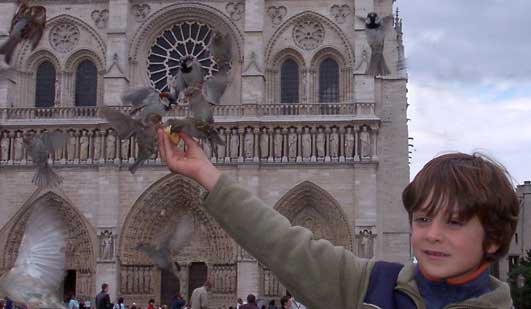 HOSP being fed bread by tourists in front of Notre Dame Cathedral in Paris. HOSP tend to congregate where scraps are available, such as outside fast food restaurants. Some people think HOSP are cute, but many bluebird landlords consider them the equivalent of “rats with wings.” HOSP being fed bread by tourists in front of Notre Dame Cathedral in Paris. HOSP tend to congregate where scraps are available, such as outside fast food restaurants. Some people think HOSP are cute, but many bluebird landlords consider them the equivalent of “rats with wings.” |
||
 Male House Sparrows. Notice gray cap with chestnut underneath. Male House Sparrows. Notice gray cap with chestnut underneath.
House Sparrows are aggressive, and will attack and destroy bluebird eggs, nestlings and adults. It is better to have no nestbox at all than to allow House Sparrows to reproduce in one. |
||
More information about HOSP on this website (sialis.org):
|
||
– Trudy Pischer (Bluebird_Listserv), 2005

 Female House Sparrow back view.
Female House Sparrow back view.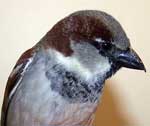
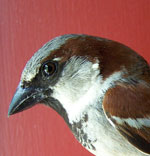




 House Sparrow
House Sparrow